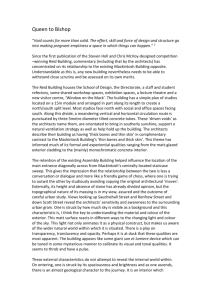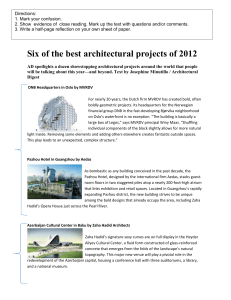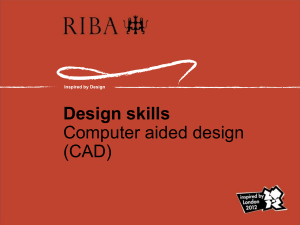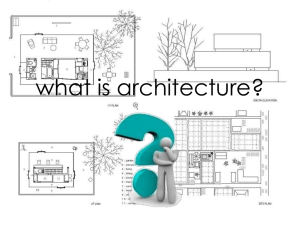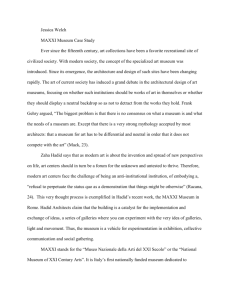FinalDraft_Tashina
advertisement
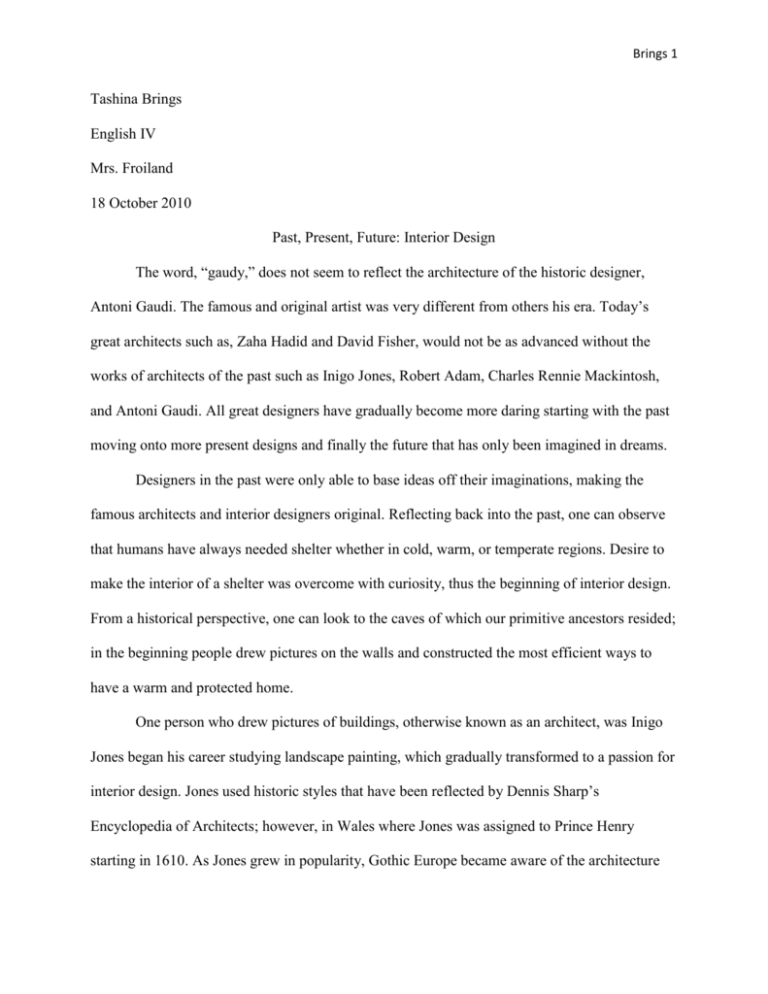
Brings 1 Tashina Brings English IV Mrs. Froiland 18 October 2010 Past, Present, Future: Interior Design The word, “gaudy,” does not seem to reflect the architecture of the historic designer, Antoni Gaudi. The famous and original artist was very different from others his era. Today’s great architects such as, Zaha Hadid and David Fisher, would not be as advanced without the works of architects of the past such as Inigo Jones, Robert Adam, Charles Rennie Mackintosh, and Antoni Gaudi. All great designers have gradually become more daring starting with the past moving onto more present designs and finally the future that has only been imagined in dreams. Designers in the past were only able to base ideas off their imaginations, making the famous architects and interior designers original. Reflecting back into the past, one can observe that humans have always needed shelter whether in cold, warm, or temperate regions. Desire to make the interior of a shelter was overcome with curiosity, thus the beginning of interior design. From a historical perspective, one can look to the caves of which our primitive ancestors resided; in the beginning people drew pictures on the walls and constructed the most efficient ways to have a warm and protected home. One person who drew pictures of buildings, otherwise known as an architect, was Inigo Jones began his career studying landscape painting, which gradually transformed to a passion for interior design. Jones used historic styles that have been reflected by Dennis Sharp’s Encyclopedia of Architects; however, in Wales where Jones was assigned to Prince Henry starting in 1610. As Jones grew in popularity, Gothic Europe became aware of the architecture Brings 2 from Rome and the Italian Renaissance. Jones became an esteemed man as his work became known; furthermore, he had been selected to be the surveyor-general of royal buildings. Intertwined with his creativity came science, where Jones had been employed by the king to find the origin of Stonehenge (NNDB). Inigo Jones was far from stumped as a creator of originality. Jones’ ideas consisted of classical construction including: Roman-like pillars, marble, and sculpted religious murals. Cherubs, a child-like angel, were common among the many details Jones put into his works. Later, Robert Adam became Scotland’s most famous architect for being a leader of classical revival in Europe as well as for his use of colors. According to Dennis Sharp, Adam incorporated light, color, and intricate ornamentation and was influenced by classical Italian, French and Renaissance to form his personal style (11). Styles from early architects were merely melting pots molded into one’s unique method. Interestingly enough, a room designed by Adam himself was where Joseph Priestly indentified oxygen in 1774 (Rubin). Robert Adam designed things in a way to make royalty feel more powerful than what they were by giving each room and building a Romanesque touch and using bold colors. If a sense that history and beauty can keep something alive, the works of Robert Adam continue to reel in fame from modern spectators. Present day techniques in designing are what we call formal or presentable; one can look at a farm house to a house built in 2010 as a present architectural structure. Looking at architecture is easily done but the minor details are what matters most during the observation; the contours of each design, the grandness of the entrance, the overall feeling one gets when walking into an architectural establishment is what a person looks for in a building. Although the designing is based on the originals, each piece of work is given decent amounts of personality to Brings 3 make it unique. Designs considered in the “now” are often just ideas from the past with a new spin on them. Creativity is never-ending for the creative mind and to rewrite what has already been done is a great accomplishment for the legacy of an architect. The architects of the present day works are amazing in the sense that they have taken someone from the past and turned it into their own. Charles Rennie Mackintosh would not be considered modern from his era, but in today’s expectations his works showed to be advanced. Alan Crawford and Wendy Kaplan explain that “the Willow Tea Rooms in Sauchihall Street were one of his [Charles Mackintosh] most original buildings,” where he juggled with space, used color and lighting according to gender, and made the rooms feel luxurious (Crawford). While Mackintosh was still in the Glasgow School of Art, he formed an artistic relationship with four other architects creating his grand reputation. The spatial and crispness of each tea room displayed his skill in using artificial lighting and detail; he felt that every large work of art was highly contributed by each small piece it took to put it together according to John Wiley and Sons (History of Interior Design). Looking at Charles’ work, it’s easily told that his work is to not only be a job but a love and passion for architecture and design. An architect who started the present design, Antoni Gaudi, used what Muriel Emmanuel described as “flowing curves and unusual decorative details” to show his personality through his works (Emmanuel). Gaudi’s odd details proved to make a statement and have shown to pass down through generations of architects. Today’s buildings and homes have shown to be influenced by the past, yet in the light of things shown to change and mold into its own idea for the present design. Gaudi’s overall emotions he portrayed were something like openness and honesty. Facts of his life were dull; Gaudi was a bachelor his entire life – something that seems Brings 4 to be required for the Romantic architecture – making his designs seem suitable for describing him in his works. Continuing on, finding that he was not interested in his era, but longing for the structure from the past. Gaudi did his greatest work in Barcelona; the cathedral showed that he respected the religious history. As Gaudi’s works continue to diminish, his story remains intact. Future architecture is not what designing will look like years from now, but the idea of futuristic architecture in our modern everyday lives. Unusual shapes and colors, green energy and size, even living rooms are completely different than what people of today are used to when it comes to the future of architecture. A cycle has come full turn and architects are finding that they must meet the demands of a new era; furthermore, one can see that solar and more energy efficient changes are being brought up as obstacles for architects. Homes that have solar panels and energy saving appliances are not uncommon; a home that is even in a different shape can save varying amounts of money and the world’s carbon footprint. An example of an energy efficient home is a dome shaped home. Dome homes, according to Albata Domes, are “energy efficient, superior in strength, easy to assemble, ecologically friendly, spacious, expandable, and economical.” Zaha Hadid is a current architect who has built amazing buildings that display the contemporary view such as having sharp, distinct walls that are in irregular shapes. From her press released biography, they praised her by saying she “consistently pushes the boundaries of architecture” (Zaha Hadid Architects). Being a leading contemporary woman of architecture, Hadid is known widely transpose for being able to bring her works to any country or culture solely on the fact that she can incorporate an overall aspect that her works can blend in anywhere. Born in Iraq, her style and femininity is portrayed through her light hearted, beautifully crafted designs. Hadid’s work has been compared to that of an Asian artisan’s brush Brings 5 stroke by Donna Koran who wrote of Zaha Hadid in the 2010 Time 100 edition of Time Magazine (The 2010 Time 100). Hadid continues to keep her life moving by taking on many titles in the world and taking on many time consuming projects. To show one can leave a “green” imprint the designing world, David Fisher shows the idea of conservation of energy in his works. Working for Dynamic Architecture, his greatest idea has proven to be the greenest; a wind powered building that turns with the changes of wind. Futuresque styles are not merely for the looks but to improve the human quality of living. David Fisher has taken on the challenge of turning architecture into its own energy source. He has been found to know more about architecture in the sense that he knows how to build, manage, develop, teach, and design a project – basically he has walked in everyone’s shoes. David didn’t show much expansion with his many hotel and business building input, but Fisher has made an exponential imprint on the world of architecture and has continued to surprise the world by his intriguing and innovative design. As explained prior it takes technique to make oneself known for style, originality, and persistence; however, it takes a true artist to harness the emotion and passion of each piece of work. “It’s not all about the cake, it’s about the frosting; without the reaction of the customer my job wouldn’t be complete,” said Jeanne Foote, a local interior designer, explaining that it’s not all about the money but it is about listening and the overall happiness of the customer. To become well known in this field, it takes many mistakes, triumphs, and achievements as an architect or interior designer. Throughout the past, the present, and the future, many individuals have made themselves a mark in history and a major part in answering questions in history. Brings 6 Annotated Work Cited Albata Domes. "Affordable Geodesic Domes for a Better Future." Albata Domes. 09 Nov. 2010. Web This source tells of the pros in the making of dome houses and buildings. This is a reliable source because the people who wrote it are the creators of these homes. I will be using facts on the pros of having dome homes. Crawford, Alan and Kaplan, Wendy. “In the Tea Rooms of Mackintosh.” Charles Rennie Mackintosh (1996). Web This article explains the history and some of the styles of Charles Rennie Mackintosh. This source is reliable because the authors are consultants in the field of architectural history. I used the history of Charles Rennie Mackintosh to further explain his designing methods. Dynamic Communications Limited. “Dynamic Architect.” Biography. 2010. Web. The history on David Fisher’s career as an architect is outlined in this article. This source is reliable because it’s current and up to date. David Fisher’s accomplishments and designs will be used. Emmanuel, Muriel. Contemporary Architects. New York: St. Martin's Press, 1980. Brings 7 Antoni Gaudi’s history is told in this source and the history of the buildings he’s worked on. This is a reliable source because the author has taken factual information to put it together. The history of Antoni Gaudi’s buildings will be used. Gareth Rubin. "Designed for life. " FT.com 11 Jul 2009: Research Library, ProQuest. Web. 26 Oct. 2010 Multiple interior designers are explained and given a brief background evaluation. This source is reliable because it shows that it’s been studied. Descriptions and facts will be used. Jeanne Foote. Personal Interview. 10 November 2010. Questions about interior design and her experiences are answered. This is a reliable source because I asked her the questions myself and got the actual reactions. A quote about what interior design is all about is used in the research paper. John Wiley & Sons. “History of Interior Design.”History of Interior Design (2000): Web. The article explains great interior designers of the past. This is a reliable resource because it it’s fluent with my other sources and information. I used some examples of the famous designers in my paper. Karan, Donna. “Zaha Hadid.” The 2010 Time 100. 29 April 2010.Web. Information on Zaha Hadid and her works are in the article. This is a reliable source because it has been published. Thoughts and facts will be used in the research paper. “NNDB.” Soylent Communications, 2010. Web. Inigo Jones’ history is explained thoroughly in this source. This source is reliable because it’s pooled information from different books based on Jones. The information used from this article, is the history of Inigo Jones. Brings 8 Sharp, Dennis. The Illustrated Encyclopedia of Architects and Architecture. New York: Quatro Publishing, 1991. Web. In this article, the history of Inigo Jones and the history of some of his famous buildings are explained. This source is reliable because the author wrote an entire encyclopedia of architects. Used from this article was information on the history of Inigo Jones and his styles. Zaha Hadid Architects. “Zaha Hadid.” Biography. 2010. Web. Zaha Hadid’s history is told in this source as well as her accomplishments. This source is reliable because it was written by her press department. The information use from this article is the history of Zaha and the buildings she created.

